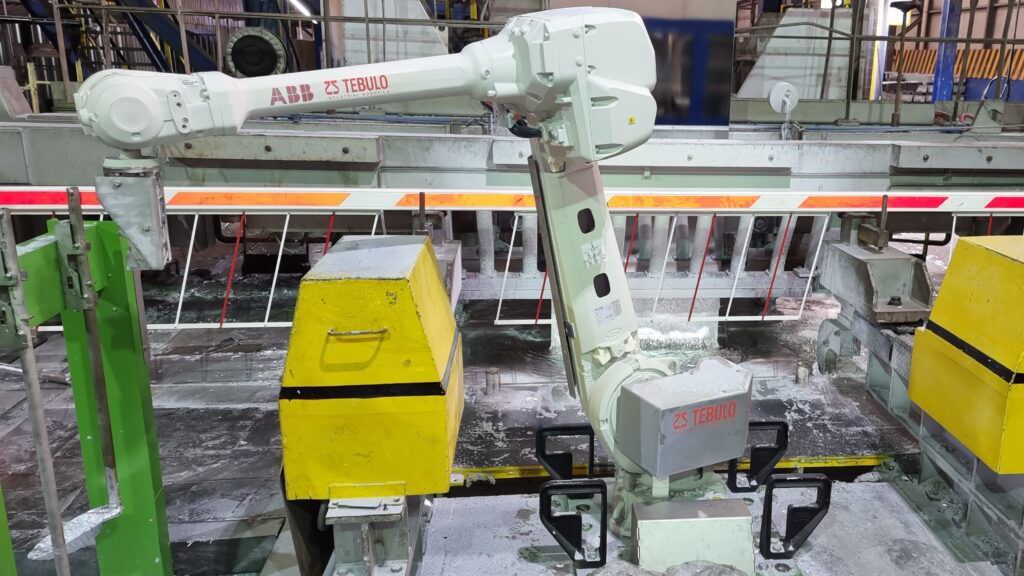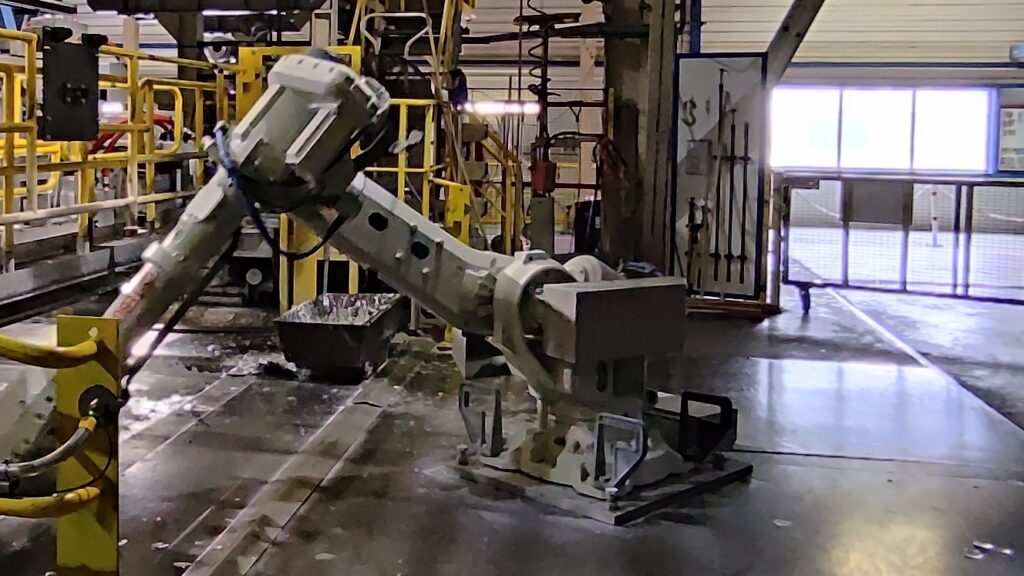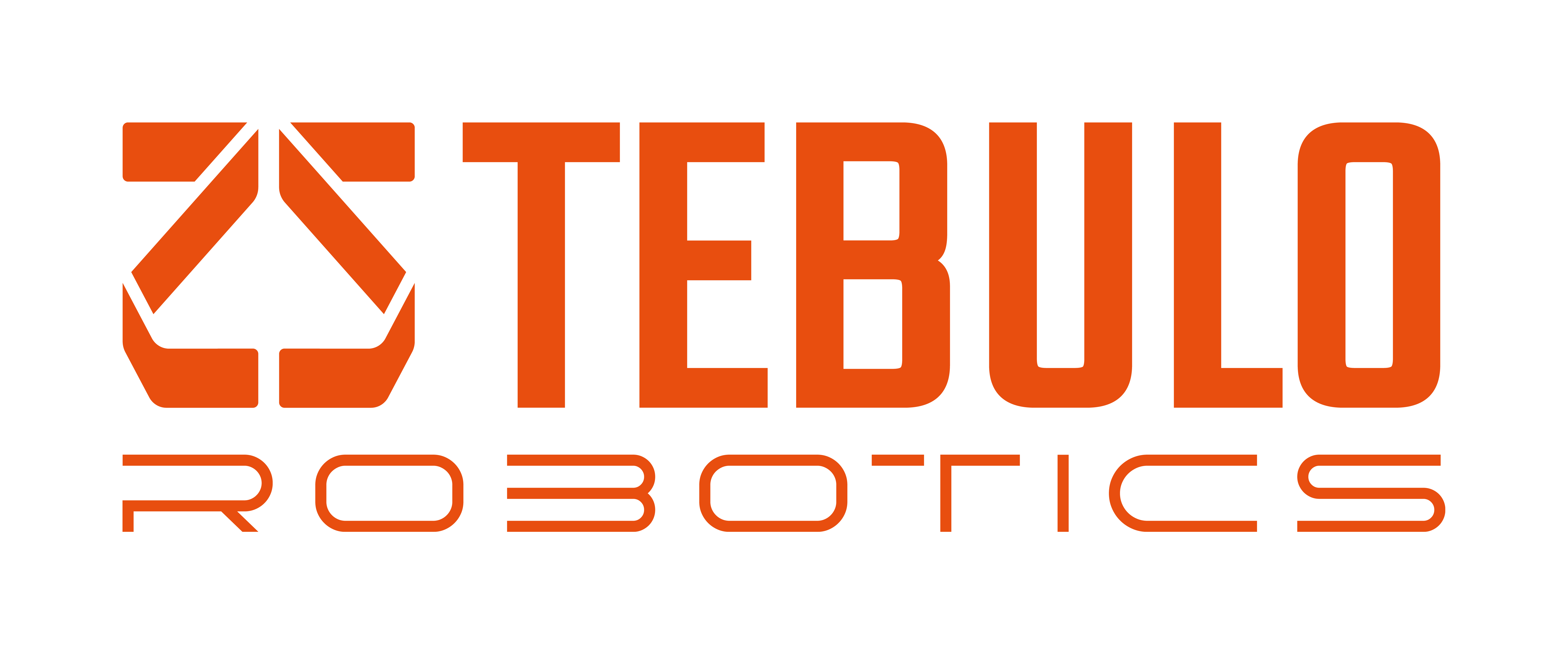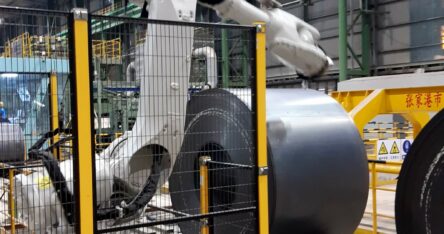Robotic Dross Removal Is The Future
Stahl und Eisen, Nr. 1-2 | Januar-Februar 2022
THAT’S WHAT IT’S ABOUT: The current production process entails pulling a preheated plate of steel through a 400- 500°C zinc bath. Operators must wear uncomfortable protective clothing, while manually scooping the dross from the bath in an extremely hot environment. It is a daily reoccurring and definitely unsafe situation, with all the risks that it entails. Particularly for such production environments, Tebulo Industrial Robotics has developed a robotic dross system with smart tools, which allows for easy implementation in any existing production process of galvanizing steel. Even with limited space.

Providing 24/7 dross removal from both sides of the steel plates to prevent any contamination, while increasing the operators’ safety and ease and ensuring a continuous, high quality of galvanized steel plates.“ These were the main instructions for Tebulo Industrial Robotics regarding the development of the recently introduced dross-robotic system. This solution stands out since it may be integrated into any existing production process, in spite of tight space constraints. With the new installation, there is no longer any human interference. The manufacturer opted for an ‘out of the box’ solution with a front robot and a V-side robot, smart, user-friendly control software and a patented tool changer.
Process
In the continuous galvanizing process, a steel plate is fed through an inert nitrogen environment furnace minimizing exposure to oxygen and dipped directly into a zinc bath. The deflector roll submerged in the zinc bath deflects the plate and covered in a thin zinc layer on both sides leaves the bath were the air knives blow off excess zinc, leaving a wafer-thin zinc coating of a constant thickness. During zinc application, the steel plate is kept as stable as possible by means of stabilizers, correction rollers and/or stabilizing magnets. Under extreme conditions, operators must manually scoop the dross (read: contamination resulting from a chemical reaction) from the zinc bath during every shift. Hans Spaans, Technology Director with Tebulo Industrial Robotics explains: „Oftentimes this takes place just too late, causing dross accumulation and contamination on the steel plate. This compromises the steel plate’s corrosion resistance and negatively affects the finished product’s appearance, not to mention that it causes unsafe working conditions for the employees.“
Number of Robots
Dross removal may be carried out with 1, 2 or even several robots. It depends on various factors, such as the available space surrounding the steel plate, the desired end result, the process in the zinc bath and the available investment budget. Especially with existing zinc baths, the installation of two robots is already quite a challenge, since space is limited. Spaans: „Such a situation requires a creative and safe solution, so that the existing installation remains fully intact, while the use of robots allows for the most optimized processing. We realized this by suspending a V-side robot from a track (i.e.: a kind of overhead rail system) over the zinc bath. It was equipped with various tools and programmed to cooperate with the front-side robot.“
Suspended V-side Robot
The track from which the V-side robot is suspended was mounted to the furnace existing steel structure, allowing it to move from left to right and vice versa. To ensure the required rigidity in this construction, an additional gantry was added to support the track. The V-side robot works with two types of rakes on the steel plate’s rear (V-side) and ensures that the dross is offered in a controlled way in the front-side robot’s operational area, so that the latter can handle the dross-removal process from there. Both robots operate with an in house designed tool changer to ensure a maximum flexibility to select the tool made to measure for each individual project application to accomplish an optimized dross removal process. As mentioned above, we work with 2 types of rakes for the V-side robot and we utilize a total of 4 types of rakes and shovels for the front robot. Rob Beentjes, General Director of Tebulo Industrial Robotics adds: „It is important that the zinc bath be disturbed as little as possible to achieve the highest possible zinc quality. In other words, all necessary movements, such as raking and scooping out the dross, must be carried out as gently and efficiently as possible at all times.“

Tool Changer
Particularly noteworthy is the fully mechanically operated, patented tool changer system. This system consists of a tool station with individual rakes and/or shovels as well as a robot actuated tool changer (EOAT, End of Arm Tooling) with an ingenious attachment system. The entire tool changer system is suitable for the rough environment.
Spaans explains further: “Most of the tool changers on the market are pneumatically or electrically driven and therefore less suitable for use in heavy-duty environments contaminated by zinc dust. This is what prompted the idea to develop a suitable tool changing system of our own, where the robot with a robust gripper can fetch, return and secure the tools by itself. Thanks to the use of robotic movements additional cylinders and/or electric actuators are now superfluous. The result is a patented robust solution called the robot-actuated tool changer. The tool station is set up within the robot’s reach. As soon as the robot removes a tool, it is mechanically locked in place with the robust coupling mechanism, measured and calibrated. After use, the tool is replaced and unlocked. Says Beentjes: „Work is done with a unique pick-up and parking spot or a kind of key system, based on the Japanese poka-yoke system.“ In short: the key system is secured because each tool has a pick-up point with its own design. So it is impossible that tools end up in the wrong place when changing a tool. The tool assignment is constantly monitored by means of switches. Meanwhile, Tebulo Industrial Robotics has built and supplied a number of different tool stations for various applications worldwide.
Multifunctional Deployable
Aside from removing dross, the robot may also be used to carry out other types of work, such as cleaning the surroundings, placing or moving the 5-meter-wide safety fence, or taking zinc samples. Other attributes can be effortlessly attached to the robot, for example for sampling purposes. „The option to place (or move) the fence had already been incorporated within the initial robot design“, remembers Spaans. „Three positions in total have been set up where the fence may be placed. For example, the robot places the fence on the edge of the zinc pot during production when people want to enter the safety area (position 2). During the zinc pot’s change or in case of standstill the fence is positioned about one meter from the edge of the zinc pot to close the gap when zinc pot is removed (position 1). During production if there are no people in the robot’s working area, then it hangs the safety fence at the parking position (position 3) above the zinc bath. As with the tool change system described earlier, the ‘robot-actuated tool changer’ with additional double hooks and an adaptor plate on the safety fence is used to handle it properly and in a stable manner. The safety fence’s stability and its positioning are essential aspects when the robot hangs it up. So, it is interesting to note that the components’ shape is such that the fence automatically centres itself on pre-programmed positions, as soon as the robot places or removes it in a controlled manner.
User-friendly HMI
For every zinc pot, Tebulo Industrial Robotics prepared in advance five different programs, so the most ideal movement procedure may be selected based on different process variables. For each program, robot movements are programmed in such a way that all corners and walls of the zinc pot are within reach of the specially manufactured tools. Control for each zinc pot program may subsequently be easily optimized via the advanced, extremely user- friendly HMI. Spaans explains: „In addition to the five automated cycles, it is also possible to manually set up one’s own cycle. For each of the pre-programmed options, the operator may first decide to play a video showing the movements the robot will make. As soon as the desired movements are discovered, the operator may activate the final selection.

Dross Bin
Next to the robot, in front of the zinc bath, the operator places an empty dross bin in a dedicated area in which all dross scooped from the zinc ends up. Once the (empty) dross bin is put in its place, the robot is able to detect and confirm its correct position and monitor filling level with the sensor integrated into the robot arm. When the dross bin is almost full, the sensor reports this to the HMI, so that the operator can replace the bin in time. Moreover, the dross bin level is displayed on the HMI.
Removable Front Robot In case the steel plate breaks, or if the operator needs more space during a stoppage, the front robot may simply be removed from its spot by a forklift. This creates a completely even (flush) floor area, free of trip hazards. Optionally, a winch drive may be set up in the free space to haul the steel plate back into position. Moreover, the free space may be utilised to safely perform necessary tasks for the zinc bath. Particularly with the option of removing or returning the robot, Tebulo Industrial Robotics produced an ingenious robot fastening construction allowing for continuous positioning accuracy.
All in All
The introduction of the aforementioned robotic dross removal system, has substantially improved the operators’ working conditions as well as the zinc plate’s quality. The above-mentioned development is extremely interesting for types of industry where continuous high product quality and operator safety are the absolute requirements.


